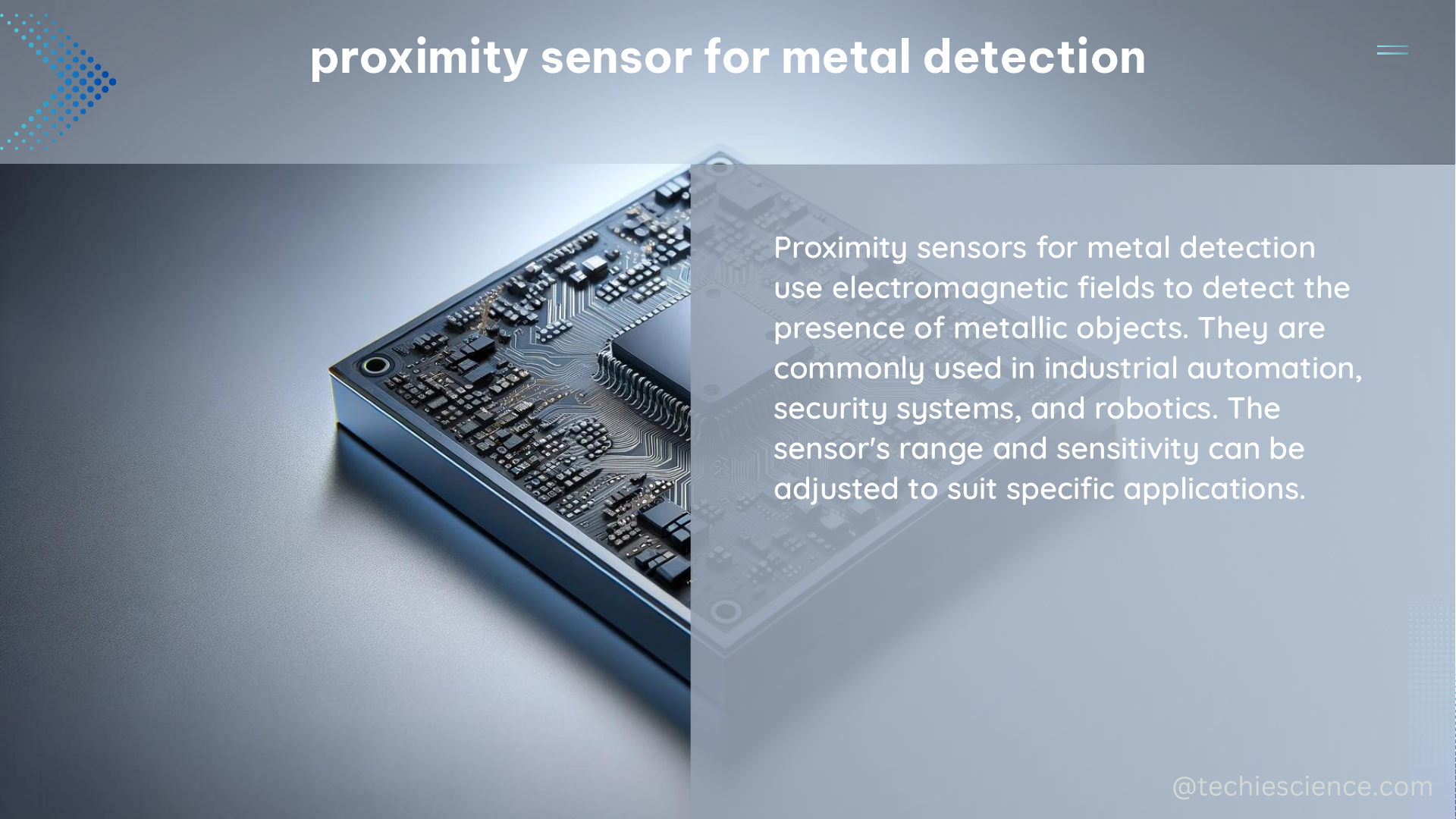Proximity sensors for metal detection are essential in various applications, including industrial automation, robotics, and medical devices. These sensors can detect the presence and distance of metal objects without physical contact, relying on electromagnetic fields or infrared radiation. The sensitivity and accuracy of proximity sensors depend on their technical specifications, such as detection range, response time, and linearity.
Inductive Proximity Sensors
One type of proximity sensor for metal detection is the inductive proximity sensor, which uses an electromagnetic field to detect metal objects. The detection range of these sensors depends on the sensor’s size and frequency, with larger sensors and higher frequencies providing longer ranges.
- Detection Range: A typical inductive proximity sensor with a 10mm diameter and a frequency of 1MHz can detect a 3mm thick steel plate at a distance of up to 2mm.
- Sensor Size: Inductive proximity sensors are available in various sizes, ranging from 3mm to 30mm in diameter, allowing for flexibility in installation and application requirements.
- Frequency: Inductive proximity sensors operate at frequencies ranging from 100kHz to 1MHz, with higher frequencies providing longer detection ranges.
- Linearity: Inductive proximity sensors maintain a linear output signal over their detection range, ensuring accurate distance measurement.
- Response Time: These sensors have a fast response time, typically in the range of 0.1 to 2 milliseconds, enabling rapid detection of metal objects.
Capacitive Proximity Sensors

Another type of proximity sensor for metal detection is the capacitive proximity sensor, which uses a capacitive field to detect metal objects. These sensors can detect both metallic and non-metallic objects, but their sensitivity to metals is higher due to the higher dielectric constant of metals.
- Detection Range: A capacitive proximity sensor with a 10mm diameter and a frequency of 100kHz can detect a 3mm thick aluminum plate at a distance of up to 5mm.
- Sensor Size: Capacitive proximity sensors are available in sizes ranging from 6mm to 30mm in diameter, providing flexibility in installation and application requirements.
- Frequency: These sensors operate at frequencies ranging from 50kHz to 500kHz, with higher frequencies offering longer detection ranges.
- Capacitance: The capacitance of the sensor, typically ranging from 10pF to 1000pF, determines the sensor’s sensitivity and detection range.
- Response Time: Capacitive proximity sensors have a response time in the range of 0.5 to 5 milliseconds, slightly slower than inductive sensors but still suitable for many applications.
Other Proximity Sensors for Metal Detection
In addition to inductive and capacitive proximity sensors, there are other types of sensors for metal detection, such as ultrasonic and optical sensors.
Ultrasonic Proximity Sensors
- Detection Principle: Ultrasonic proximity sensors use sound waves to detect metal objects.
- Detection Range: These sensors can typically detect metal objects at distances ranging from 20mm to 8 meters, depending on the sensor model and application.
- Advantages: Ultrasonic sensors can detect both metallic and non-metallic objects, and they are not affected by the color or surface finish of the target.
Optical Proximity Sensors
- Detection Principle: Optical proximity sensors use light, such as infrared or laser, to detect metal surfaces.
- Detection Range: Optical proximity sensors can detect metal objects at distances ranging from a few millimeters to several meters, depending on the sensor type and application.
- Advantages: Optical sensors are highly accurate and can provide precise distance measurements, making them suitable for applications that require high-resolution detection.
Selecting the Right Proximity Sensor for Metal Detection
When selecting a proximity sensor for metal detection, it is essential to consider the following technical specifications:
- Detection Range: Determine the required detection range based on the application requirements.
- Response Time: Choose a sensor with a response time that matches the speed of the application.
- Linearity: Ensure the sensor maintains a consistent output signal over the detection range.
- Sensor Size: Select a sensor size that fits the available space and installation requirements.
- Environmental Factors: Consider the operating temperature, humidity, and other environmental conditions that may affect the sensor’s performance.
- Power Requirements: Ensure the sensor’s power supply and consumption are compatible with the application.
- Output Signal: Choose a sensor with the appropriate output signal (e.g., analog, digital, or IO-Link) for the control system.
By carefully considering these technical specifications, you can select the most suitable proximity sensor for your metal detection application, ensuring reliable and accurate performance.
Conclusion
Proximity sensors for metal detection are essential in various industries, providing non-contact detection of metal objects with high sensitivity and accuracy. Inductive and capacitive proximity sensors are the most common types, offering different detection ranges, response times, and linearity characteristics. Other sensor types, such as ultrasonic and optical, are also available for specific applications.
When selecting a proximity sensor for metal detection, it is crucial to carefully evaluate the technical specifications to ensure the sensor meets the application requirements. By understanding the capabilities and limitations of each sensor type, you can make an informed decision and optimize the performance of your metal detection system.
References:
- Proximity Sensors for Metal Detection. Retrieved from https://www.balluff.com/global/en/products-services/technical-support/knowledge-base/knowledge-base-detail/kbid/1175/
- Proximity Sensors. Retrieved from https://www.omron.com/global/en/technology/sensing/proximity_sensors/
- Proximity Sensors for Industrial Automation. Retrieved from https://www.sick.com/us/en/products/proximity-sensors/
- Ultrasonic Proximity Sensors. Retrieved from https://www.pepperl-fuchs.com/global/en/classid_159.htm
- Optical Proximity Sensors. Retrieved from https://www.keyence.com/products/sensor/proximity-sensor/optical/

The lambdageeks.com Core SME Team is a group of experienced subject matter experts from diverse scientific and technical fields including Physics, Chemistry, Technology,Electronics & Electrical Engineering, Automotive, Mechanical Engineering. Our team collaborates to create high-quality, well-researched articles on a wide range of science and technology topics for the lambdageeks.com website.
All Our Senior SME are having more than 7 Years of experience in the respective fields . They are either Working Industry Professionals or assocaited With different Universities. Refer Our Authors Page to get to know About our Core SMEs.